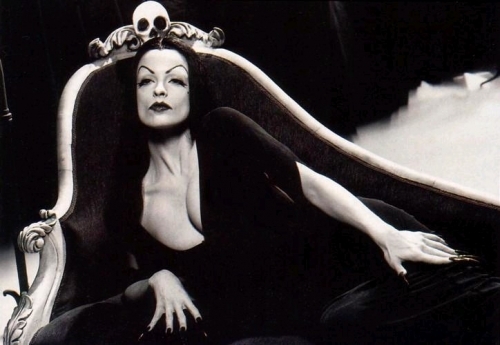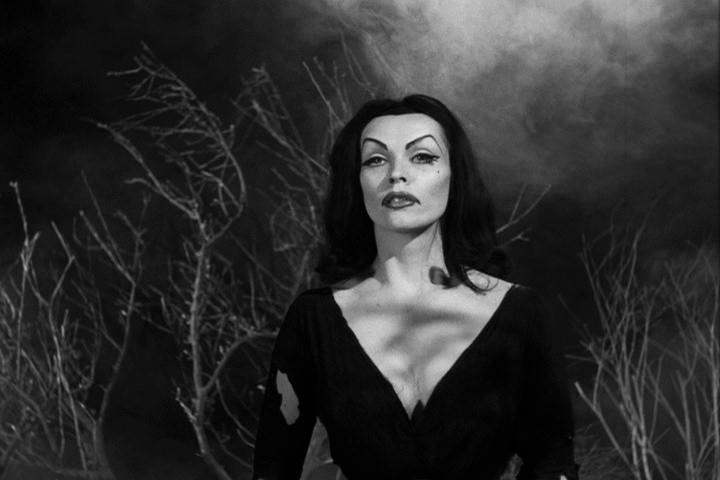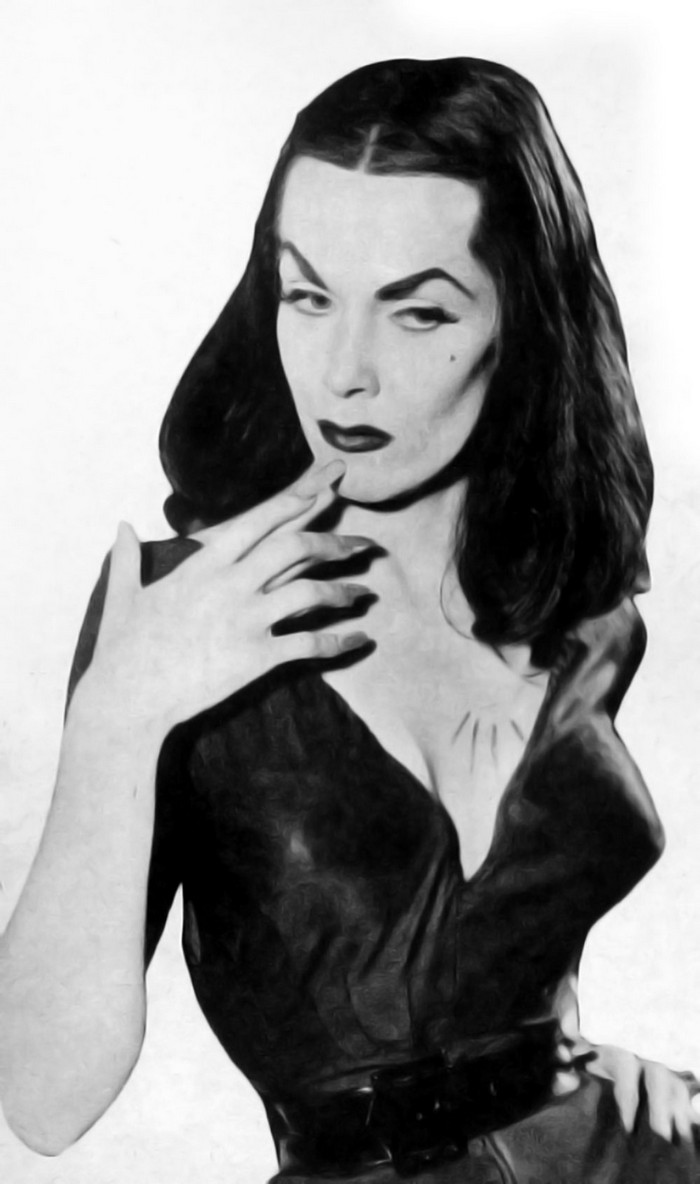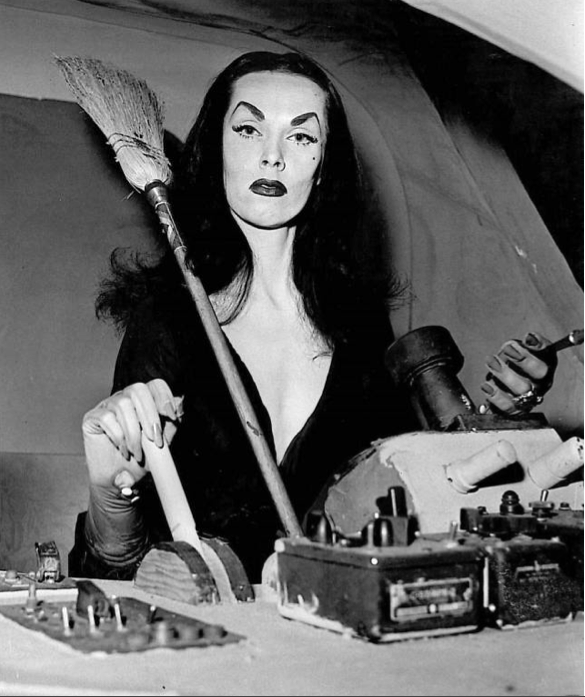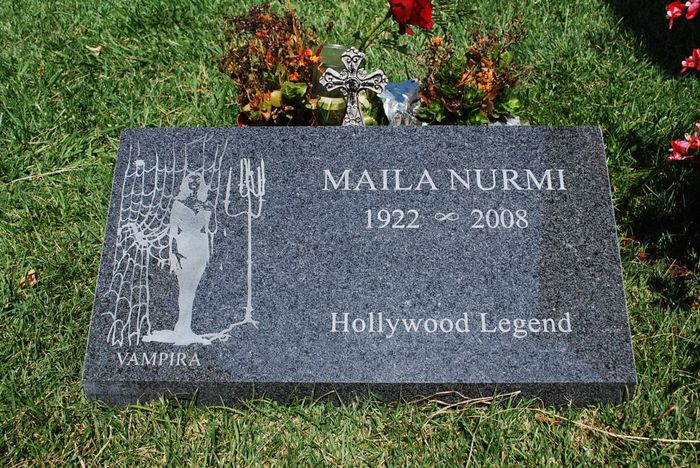Maila "Vampira" “Vampira” Nurmi (Maila Nurmi)
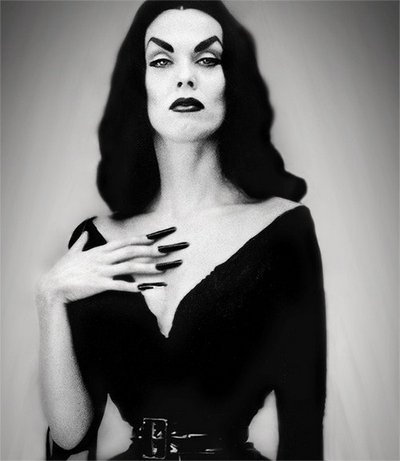
Born as Maila Elizabeth Syrjäniemi, she claimed to be the niece of the Finnish athlete Paavo Nurmi, who began setting long-distance running world records in 1921, the year before her birth. She moved to the United States with her family when she was two years old and grew up in Ashtabula, Ohio, home to the largest Finnish-American community in the state. She and her family lived in Ashtabula until 1939, when they moved to Oregon. She graduated from high school in Astoria, Oregon, before arriving in Los Angeles. She modeled for Alberto Vargas, Bernard of Hollywood, and Man Ray, gaining a foothold in the film industry with an uncredited role in Victor Saville’s 1947 film, If Winter Comes.
She reportedly was fired by Mae West from the cast of West’s Broadway play Catherine Was Great in 1944 because West feared that she was being upstaged. On Broadway, she gained much attention after appearing in the horror-themed midnight show Spook Scandals, in which she screamed, fainted, lay in a coffin and seductively lurked about a mock cemetery. She also worked as a showgirl for the Earl Carroll Theatre and as a high-kicking chorus line dancer at the Florentine Gardens along with stripper Lili St. Cyr. In the 1950s she supported herself mainly by posing for pin-up photos in men’s magazines such as Famous Models, Gala and Glamorous Models. Before landing her role as ‘Vampira’, she was working as a hat-check girl in a cloakroom on Hollywood’s Sunset Strip.
The idea for the Vampira character was born in 1953 when Nurmi attended choreographer Lester Horton’s annual Bal Caribe Masquerade in a costume inspired by Morticia Addams in The New Yorker cartoons of Charles Addams. Her appearance with pale white skin and tight black dress caught the attention of television producer Hunt Stromberg, Jr. (1923–86), who wanted to hire her to host horror movies on the Los Angeles television station KABC-TV, but Stromberg had no idea how to contact her. He finally got her phone number from Rudi Gernreich, later famed as the designer of the topless swimsuit. The name Vampira was the invention of Nurmi’s husband, Dean Riesner. Nurmi’s characterization was influenced by the Dragon Lady from the comic strip Terry and the Pirates and the evil queen from Disney’s Snow White and the Seven Dwarfs.
On April 30, 1954, KABC-TV aired a preview, Dig Me Later, Vampira, at 11:00 p.m. The Vampira Show premiered on the following night, May 1, 1954. For the first four weeks, the show aired at midnight, moving to 11:00 p.m. on May 29. Ten months later, the series aired at 10:30 p.m., beginning March 5, 1955. Each show opened with Vampira gliding down a dark corridor flooded with dry-ice fog. At the end of her trance-like walk, the camera zoomed in on her face as she let out a piercing scream. She would then introduce (and mock) that evening’s film while reclining barefoot on a skull-encrusted Victorian couch. Her horror-related comedy antics included ghoulish puns such as encouraging viewers to write for epitaphs instead of autographs and talking to her pet spider Rollo. She also ran as a candidate for Night Mayor of Hollywood with a platform of “dead issues”. In another publicity stunt, KABC had her cruise around Hollywood in the back of a chauffeur-driven 1932 Packard touring car with the top down, where she sat, as Vampira, holding a black parasol. The show was an immediate hit, and in June 1954 she appeared as Vampira in a horror-themed comedy skit on The Red Skelton Show along with Béla Lugosi, Peter Lorre and Lon Chaney, Jr.. That same week Life magazine ran an article on her, including a photo-spread of her show-opening entrance and scream (June 14, 1954, pp. 107, 108, 110).
When the series was cancelled in 1955, she retained rights to the character of Vampira and took the show to a competing Los Angeles television station, KHJ-TV. Several episode scripts and a single promotional kinescope of Nurmi re-creating some of her macabre comedy segments are held by private collectors. Several clips from the rare kinescope are included in the documentaries American Scary and Vampira: The Movie.
Examination of her diaries in 2014 verify longtime rumors that in 1956 [9]she was the model for Maleficent, the evil witch in the Disney conception of the classic fairy tale “Sleeping Beauty.” In 2007, the kinescope film of Nurmi in character was restored by Rerunmedia, whose restorations include The Ed Sullivan Show and Dark Shadows. The restoration utilized the groundbreaking LiveFeed Video Imaging process developed exclusively for the restoration of kinescopes. The restoration was funded by Spectropia Wunderhaus and Coffin Case.
A reconstructed episode of The Vampira Show was released on DVD by the Vampira’s Attic web site in October 2007. The release imitated a complete episode by using existing footage of the show combined with vintage commercials believed to have been directed by Ed Wood and the full-length 1932 feature film The Thirteenth Guest. Nurmi made television history as the first horror movie hostess. In 1957, Screen Gems released a syndicated package of 52 horror movies, mostly from Universal Pictures, under the program title Shock Theater. Independent stations in major cities all over the U.S. began showing these films, adding their own ghoulish host or hostess (including Vampira II and other lookalikes) to attract more viewers.
Nominated for an Emmy Award as ‘Most Outstanding Female Personality’ in 1954, she returned to films with Too Much, Too Soon, followed by The Big Operator and The Beat Generation. Her most notable film appearance was in Ed Wood’s camp classic, Plan 9 from Outer Space, as a Vampira-like zombie (filmed in 1956, but released in 1959). In 1960 she appeared in I Passed for White and Sex Kittens Go to College, followed by 1962’s The Magic Sword. The classic clip from Plan 9 from Outer Space featuring Vampira walking out of the woods with her hands pointing straight out was used to start the original opening sequence of WPIX Channel 11 New York’s Chiller Theatre in the 1960s.
In the early 1950s, Nurmi was close friends with James Dean, and they spent time together at Googie’s coffee shop on the corner of Crescent Heights and Sunset Boulevard in Hollywood. She explained their friendship by saying, “We have the same neuroses.” Dean allegedly repudiated their friendship toward the end of his brief life. As Hedda Hopper related in a 1962 memoir that included a chapter on Dean: “We discussed the thin-cheeked actress who calls herself Vampira on television (and cashed in, after Jimmy died, on the publicity she got from knowing him and claimed she could talk to him ‘through the veil’). He said: ‘I had studied The Golden Bough and the Marquis de Sade, and I was interested in finding out if this girl was obsessed by a satanic force. She knew absolutely nothing. I found her void of any true interest except her Vampira make-up. She has no absolute.'”
The 2010 public radio documentary Vampira and Me by author/director R. H. Greene took issue with Hopper’s depiction of the Nurmi/Dean relationship, pointing to an extant photo of Dean and Vampira sidekick Jack Simmons in full Boris Karloff Frankenstein make-up as evidence of Nurmi and Dean’s friendship. The documentary also described a production memo in the Warner Bros. archive citing a set visit from “Vampira” while Dean was making Rebel Without a Cause. The Warner Bros. memo was first mentioned in the 2006 book Live Fast, Die Young: The Making of Rebel Without a Cause by Lawrence Frascella and Al Weisel, who were given access to the Rebel production files. An interview Frascella and Weisel conducted with actress Shelley Winters also uncovered an instance where Dean interrupted an argument with director Nicholas Ray and Winters so he could watch The Vampira Show on TV.
In Vampira and Me, Nurmi can be heard telling Greene that Dean once appeared in a live bit on The Vampira Show in which Vampira, dressed as a librarian, rapped his knuckles with a ruler because “he was a very naughty boy.” On June 20, 1955, Nurmi was the target of an attempted murder when a man forced his way into her apartment and proceeded to terrorize her for close to four hours. Nurmi eventually escaped and managed to call the police, with assistance from a local shop owner. She married her first husband, Dean Riesner, in 1949, a former child actor in silent films and later the screenwriter of Dirty Harry, Charley Varrick, Play Misty for Me, and numerous other movies and TV episodes. She married her second husband, younger actor John Brinkley, on March 10, 1958. She married actor Fabrizio Mioni on June 20, 1961, in Orange County, California. She had no children.
By 1962, Nurmi was making a living installing linoleum flooring. “And if things are slow in linoleum, I can also do carpentry, make drapes or refinish furniture”, she told the Los Angeles Times. In the early 1960s, Nurmi opened Vampira’s Attic, an antiques boutique on Melrose Avenue. She also sold handmade jewelry and clothing. She made items for several celebrities, including Grace Slick of the music group Jefferson Airplane and the Zappa family.
In 1981, Nurmi was asked by KHJ-TV to revive her Vampira character for television. She worked closely with the producers of the new show and was to get an executive producer credit, but Nurmi eventually left the project over creative differences. According to Nurmi this was because the station cast comedic actress Cassandra Peterson in the part without consulting her. “They eventually called me in to sign a contract and she was there”, Nurmi told Bizarre magazine in 2005. “They had hired her without asking me.”
Unable to continue using the name Vampira, the show was abruptly renamed Elvira’s Movie Macabre with Peterson playing the titular host. Nurmi soon filed a lawsuit against Peterson. The court eventually ruled in favor of Peterson, holding that “likeness means actual representation of another person’s appearance, and not simply close resemblance.” Peterson claimed that Elvira was nothing like Vampira aside from the basic design of the black dress and black hair. Nurmi claimed that the entire Elvira persona, which included comedic dialogue and intentionally bad graveyard puns, infringed on her creation’s “distinctive dark dress, horror movie props, and…special personality.” Nurmi herself claimed that Vampira’s image was in part based on the Charles Addams The New Yorker cartoon character Morticia Addams, though she told Boxoffice magazine in 1994 that she had intentionally deviated from Addams’ mute and flat-chested creation, making her own TV character “campier and sexier” to avoid plagiarizing Addams’ idea. In 1986, she appeared alongside Tomata du Plenty of The Screamers in Rene Daalder’s punk rock musical Population: 1, which was released on DVD in October 2008. According to a Daalder interview on the 2 disc special edition of Population: 1, “There was a wild lady living out in back in a shed. Tomata befriended her and found out she had played Vampira.”
In 2001, Nurmi opened an official website and began selling autographed memorabilia and original pieces of art on eBay. Until her death, Nurmi lived in a small North Hollywood apartment. Unlike Elvira, Nurmi authorized very few merchandising contracts for her Vampira character, though the name and likeness have been used unofficially by various companies since the 1950s. In 1994, Nurmi authorized a Vampira model kit for Artomic Creations, and a pre-painted figurine from Bowen Designs in 2001, both sculpted by Thomas Kuntz. In 2004, she authorized merchandising of the Vampira character by Coffin Case.
On January 10, 2008, Nurmi died of natural causes at her home in Hollywood, aged 85. She was buried in the Griffith Lawn section of the Hollywood Forever Cemetery.
Born
- December, 11, 1922
- Petsamo, Finland
Died
- January, 10, 2008
- USA
- Los Angeles, California
Cemetery
- Hollywood Forever Cemetery
- Hollywood, California
- USA


